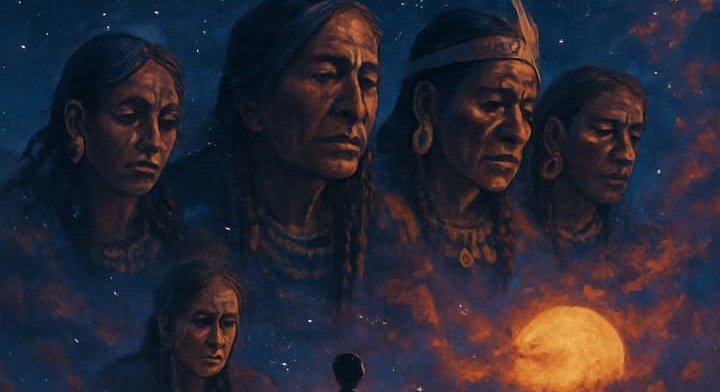By Emmanuel Mihiingo Kaija– Emkaijawrites@gmail.com
“In many indigenous traditions, the sky is not just a space; it is a story, a being, a witness, and a portal.”
—Robin Wall Kimmerer, Braiding Sweetgrass
Introduction: When the Heavens Spoke and We Forgot to Listen
The sky, for many Westerners raised in secular, post-enlightenment cosmologies, has become little more than a meteorological ceiling, a passive backdrop for satellites and sunsets. But in Indigenous traditions across Africa, the Americas, Oceania, and Asia, the sky remains a realm of revelation, interaction, and ancestral presence. Long before NASA mapped the firmament with cold instruments, African shamans, Amazonian elders, Australian songlines, and Arctic seers were reading the heavens—not just for weather or agriculture, but for communion. Sky beings—luminescent entities, chariots of fire, spiraling discs of energy, or humanoid forms descending from light—are central to Indigenous cosmologies. These encounters were never deemed delusions or mere mythologies, but were embedded in ritual, language, and sacred memory. From the Zulu stories of “abantu abangena esibhakabhakeni” (people who came from the sky) to the Dogon of Mali and their advanced astronomical knowledge of Sirius B—long before modern telescopes confirmed its existence—there is a consistent testimony that the heavens have never been silent. They have always been speaking, and Indigenous peoples, once tuned to their frequencies, have been listening.
Western anthropology and missionary theology, however, often dismissed these testimonies as superstition or diabolic error. This was no accident. As theologian Kwame Bediako notes, “the colonial project required the de-sacralization of African cosmologies in order to assert the superiority of Christian metaphysics.” Indeed, the very epistemic frameworks that underpinned missionary work often came bundled with Enlightenment skepticism—what Charles Taylor has called “the buffered self,” a secular consciousness that no longer feels porous to the divine or the unseen.[^2] In this sanitized cosmology, biblical references to angels, visions, and sky chariots were safely domesticated as metaphor or spiritual allegory, while similar accounts from Indigenous peoples were branded as heresy, hallucination, or worse—witchcraft. This theological double standard has not only marginalized non-Western voices but has also impoverished the global church’s own scriptural imagination. The sacred geography of the heavens was flattened, its mysteries exiled to the realm of fiction or fringe conspiracy.
Yet when read on their own terms, the Hebrew and Christian scriptures are radically celestial. They speak of the firmament (raqia) not as empty space, but as a structured dome holding back waters above (Genesis 1:6–8), echoing Mesopotamian and Egyptian cosmologies. The heavens are peopled—populated by seraphim (Isaiah 6), watchers (Daniel 4:17), thrones and dominions (Colossians 1:16), and wheels of fire (Ezekiel 1). In The Unseen Realm, biblical scholar Michael Heiser writes, “To an ancient Israelite, the spiritual world was not imaginary; it was densely populated, vividly structured, and in constant interaction with the human realm.”[^3] Similarly, Richard Middleton, in The Liberating Image, argues that biblical cosmology assumes “a heaven teeming with divine beings,” a view obscured by post-Enlightenment readers conditioned to disbelieve the supernatural.[^4] If the Bible offers a theologically open cosmology, then why are Indigenous peoples scorned when they report the very same visions, beings, and celestial manifestations?
This paper proceeds from the conviction that such scorn is rooted not in theological truth, but in colonial control over cosmological narratives. Western Christianity, especially as exported through missions in the 19th and 20th centuries, participated in an epistemic imperialism that demonized or erased Indigenous sky cosmologies. As theologian Emmanuel Katongole observes in The Sacrifice of Africa, “The problem is not African religiosity—it is the West’s inability to see beyond its own secular lens.”[^5] This inability has consequences. Indigenous testimonies of sky beings have often been silenced, relegated to the margins of UFOlogy or ridiculed in both religious and scientific spaces, despite a growing body of evidence that these narratives are consistent, multi-generational, and sometimes tied to archaeological and astronomical anomalies.
Take the Dogon people of Mali, whose sacred cosmology includes detailed knowledge of Sirius B—a white dwarf star invisible to the naked eye and only discovered by Western astronomers in 1862. The Dogon’s oral tradition described its density, orbit, and twin star long before telescopic verification, a fact documented by French anthropologists Marcel Griaule and Germaine Dieterlen in the 1940s.[^6] While some scholars have since questioned Griaule’s methods, no sufficient explanation has replaced the enigma. Was this knowledge passed down from celestial encounters, or is the Western refusal to accept such a possibility itself a form of intellectual colonization?
This paper reclaims Indigenous cosmologies of the sky not merely as folklore, but as legitimate theological data—worthy of dialogue with biblical cosmology, and deserving of serious academic engagement. Through a multidisciplinary lens combining biblical studies, anthropology, Indigenous epistemology, and postcolonial theology, we seek to unveil how erasures occur, how sacred voices are silenced, and how we might restore the right to believe what the heavens have always revealed. For the sky is not empty. The question is not whether the heavens spoke—but why we stopped listening.
Section I: The Heavens Declare — Reclaiming the Sky as Sacred Space in Biblical Cosmology
In the ancient Hebrew imagination, the sky was no passive backdrop to human history—it was alive, articulate, and divinely animated. The Hebrew word shamayim, often translated simply as “heavens,” carries a layered cosmological weight. It refers not merely to clouds or stars but to the realm where God’s presence dwells and from where revelation descends. Psalm 19:1 declares, “The heavens declare the glory of God; the skies proclaim the work of His hands”—not as poetic metaphor but as ontological truth. Throughout scripture, the sky is a stage upon which divine messengers appear, judgments fall, signs unfold, and covenants are ratified. Jacob’s dream in Genesis 28:12, where he beholds a ladder reaching up to the heavens and angels ascending and descending, is not a whimsical tale but a theological blueprint of the cosmos as porous—open to divine traffic. Elijah’s fiery ascent (2 Kings 2:11), Ezekiel’s visions of wheels within wheels and four-faced creatures (Ezekiel 1), and Christ’s ascension enveloped in clouds (Acts 1:9) all echo a consistent cosmological grammar: the sky is not empty, but inhabited; not silent, but speaking. It is a cosmic veil, sometimes drawn aside to reveal the divine drama beyond.
Yet this sacred cosmology has been flattened under the weight of Enlightenment rationalism and its mechanistic view of the universe. In the age of telescopes and satellites, the sky has been demoted from a realm of encounter to a site of exploration, its sacred meaning stripped and its mysteries reduced to data points. The rise of Western scientific empiricism and its secular cosmology replaced sacred awe with sterile astronomy, rendering the biblical skies quaint or allegorical. Even within modern Christianity, many believers now interpret these ancient visions as mere metaphor—dream symbols rather than spiritual realities. This desacralization of the heavens mirrors what scholar Mircea Eliade described as the “terror of history”—a loss of mythic orientation, where sacred time and space collapse into meaningless chronology and Cartesian coordinates. The colonial encounter exacerbated this shift: missionary theologies imported from Europe often suppressed the cosmologies of African, Indigenous American, and Asian peoples, branding their sacred skies as pagan illusion. Sacred mountains became geological anomalies; ancestral stars were labeled primitive superstition. But what if the biblical cosmos and the Indigenous cosmos are not enemies, but estranged kin?
Indeed, biblical cosmology may offer a key to rethinking and validating Indigenous encounters with sky beings—those luminous visitors, aerial apparitions, or fiery chariots that populate oral traditions across Africa, Oceania, and the Americas. Anthropologists such as Jeremy Narby and Malidoma Patrice Somé have noted that many Indigenous cosmologies describe the sky as a domain of spirit beings, celestial ancestors, and messengers who descend during visions, dreams, or ritual states. These are not random delusions but culturally coherent experiences situated within sacred cosmological systems. The Dogon of Mali, for example, speak of the Nommo—amphibious sky beings linked with the Sirius star system—whose descriptions predate Western astronomical discoveries of Sirius B. In South America, the Kogi and Shipibo peoples interpret certain aerial lights as spirit ancestors communicating with the earth below. Even in contemporary Uganda, elders from the Bakonzo and Acholi tribes recount ancestral encounters with mysterious beings “who walked on the wind.” Such narratives are often dismissed by the modern West as UFO folklore or tribal myth, but when viewed through the lens of biblical cosmology, they suggest a continuity of sacred sky visitations. After all, how different is a Dogon Nommo descending from Sirius from an angel descending on a ladder from heaven? Why should one be scripture and the other superstition?
This convergence calls for a theological reorientation—a hermeneutic of listening to the margins. It demands that we read scripture not only as a document of past revelation but as a living map of divine-human encounter that stretches across cultures and eras. Hebrews 13:2 reminds us, “Do not forget to entertain strangers, for by so doing some have entertained angels unawares.” The biblical authors did not imagine angelic visitations as historical anomalies but as ongoing possibilities. When Paul speaks of being “caught up to the third heaven” (2 Corinthians 12:2), he invokes a cosmology that assumed multiple heavens, spiritual ascent, and divine communication across dimensions. What has changed is not the cosmos, but the Western Christian imagination—crippled by its own disbelief. The tragedy is that this disbelief has not remained private, but has been globalized, weaponized through missions and theology to erase or ridicule non-Western understandings of the sky as sacred. The result is epistemicide: the killing of other ways of knowing.
We must ask: if the heavens spoke to the prophets, might they not still speak to the world’s Indigenous peoples? If God revealed himself through clouds, fire, stars, and angels, why should the testimonies of other sky-watchers be dismissed? In the ruins of colonial theology, there lies a prophetic possibility—an invitation to rediscover the sky as sacred text. As the Akan proverb says, “Wo werɛ fi na wosankɔfa a, yenkyi”—”It is not wrong to go back for that which you have forgotten.” We have forgotten the sky. We have forgotten that it speaks.
Section II: When the Earth Watches the Sky — Indigenous Cosmologies and Sky Beings as Sacred Witnesses
Across continents and millennia, Indigenous peoples have looked upward with eyes and hearts attuned to the mysteries above, weaving the sky into the very fabric of their existence. Far from idle stargazing, this gaze enshrines the heavens as living, breathing realms where ancestors, spirits, and cosmic beings dwell and act. Among the San of Southern Africa, the “/Xam” narratives speak of celestial beings called !kia, described as luminous, shape-shifting entities who traverse the boundary between visible and invisible worlds. These sky beings are not mere folklore but active agents in the maintenance of cosmic balance and the transmission of sacred knowledge. Anthropologist David Lewis-Williams, in his seminal work The Mind in the Cave (2002), elucidates how San rock art portrays these otherworldly visitors in trance-induced visions, revealing a spiritual ecology where sky, earth, and spirit interlock in a seamless whole.
In West Africa, the Dogon people’s intricate cosmology demonstrates a sophisticated understanding of astronomy interwoven with spiritual narrative. Their oral tradition recounts the Nommo—ancestral sky beings sent from the Sirius star system—who brought laws, agriculture, and social order to humanity. French anthropologists Marcel Griaule and Germaine Dieterlen documented this cosmology extensively in the mid-20th century, noting how the Dogon’s knowledge of Sirius B, a star invisible to the naked eye, suggests either ancient celestial revelation or profound spiritual insight transmitted through generations. This challenges Western epistemological arrogance and calls into question the dismissive stance often taken toward Indigenous knowledge systems. The Dogon cosmology insists that the cosmos is alive, communicating with humans through sacred knowledge encoded in myth, ritual, and sky phenomena.
Similarly, in the Americas, Indigenous sky cosmologies offer profound parallels. The Hopi people of the southwestern United States speak of Kachinas—spirit beings that descend from the sky to guide, heal, and instruct their communities. These beings are embodied in ritual dance and masked ceremony, signaling the porous boundary between the earthly and celestial realms. Ethnographer Alfonso Ortiz emphasizes that the Kachinas are not symbols but living presences, integral to the Hopi understanding of time, morality, and the unfolding cycles of nature. In Amazonian cosmologies, shamans describe “sky serpents” and “light beings” who appear during trance journeys, conveying healing wisdom and cosmic balance. The late shaman and scholar Malidoma Patrice Somé recounts how these aerial visitors serve as ancestral messengers and guardians, reinforcing the interdependence of sky and earth.
The breadth and depth of these Indigenous sky narratives resonate strikingly with biblical cosmology’s portrayal of a populated, communicative heavens. Both traditions attest to a cosmos alive with agency—angels and spirit beings who traverse the realms, messengers of divine will or ancestral wisdom. Theologian Mark Noll has argued that the modern Western rejection of supernatural cosmologies is a historical aberration, not a universal norm, and that many premodern and non-Western cultures embraced a spiritually animated universe. The global persistence of sky beings, from biblical cherubim to Dogon Nommo and Hopi Kachinas, suggests a shared human intuition about the sacred sky, transcending cultural boundaries.
Yet, the encounter between Western Christianity and Indigenous cosmologies has often been fraught with erasure. The colonial enterprise did not simply export the gospel but exported a cosmology that delegitimized Indigenous sacred skies, branding their visions “pagan” or “delusion.” As theologian Kwame Bediako notes, this epistemic violence severed many African and Indigenous peoples from their ancestral cosmologies, replacing them with a disenchanted worldview. The paradox is that biblical texts themselves affirm a cosmos rich with divine visitation and sky beings, but the cultural filters of colonial Christianity selectively muted this truth when confronting Indigenous spirituality. This has led to a tragic fragmentation where Indigenous peoples are compelled to deny or conceal their sacred encounters to avoid stigma or persecution.
Contemporary scholarship, however, is increasingly recognizing the value of Indigenous cosmologies as vital expressions of human spirituality and as authentic encounters with the unseen. Anthropologist Claude Lévi-Strauss once described myth as “science in the making”—a way humans seek to understand and engage with realities beyond the empirical. In this light, Indigenous sky beings can be reinterpreted as genuine encounters with spiritual realities, consistent with the biblical witness to angelic visitations and heavenly journeys. Furthermore, the field of comparative religion reveals that many Indigenous spiritualities share motifs of celestial mediators, divine messengers, and cosmic thresholds, affirming a shared sacred imagination. These are not relics of a primitive past but living, vibrant cosmologies that continue to shape identity, morality, and communal life.
This recognition invites a radical decolonization of the sky—not merely reclaiming physical territories but reclaiming spiritual cosmologies and theological horizons. It calls for an embrace of pluralistic revelation where the biblical heavens and Indigenous skies coexist as complementary testimonies to a universe that is, at its core, a theater of divine-human interaction. The biblical mandate to love and honor the stranger (Leviticus 19:34) extends to embracing their cosmologies as gifts, not threats. As the Igbo proverb counsels, “Nwata bulie aka, o si na mma”—“When a child raises their hand, it is a sign of goodwill.” Indigenous sky knowledge is a raised hand inviting us into a wider, richer understanding of the sacred cosmos.
In this convergence lies the potential for healing, reconciliation, and a renewed theology that honors the fullness of divine revelation as it is experienced beyond the narrow confines of Western rationalism. The sky, as a sacred realm, calls us back to awe, mystery, and encounter. When the heavens spoke to our ancestors, they spoke to all humanity—and their voice still echoes through the night sky, waiting to be heard again.
Section III: The Eclipse of Sacred Skies — Modern Science, Western Theology, and the Silencing of Indigenous Cosmologies
The dawn of the Enlightenment ushered in a seismic shift in humanity’s understanding of the cosmos—a movement heralded as liberation from superstition but shadowed by profound loss. The skies, once alive with sacred voices and divine encounters, were redefined as cold, vast, and mechanistic expanses governed by impersonal laws. Figures such as Isaac Newton and Galileo Galilei transformed the heavens from the dwelling of angels and spirits into a clockwork of planets and gravity, measurable and predictable but devoid of spiritual agency. This new scientific cosmology, while revolutionary in its empirical power, instigated what philosopher Peter Berger termed the “disenchantment of the world.” The celestial realms became nothing more than physical phenomena to be observed, catalogued, and conquered intellectually.
Within this new framework, Indigenous cosmologies—rich in spirit beings, sacred visions, and ancestral encounters—found themselves relegated to the realm of myth, folklore, or worse, delusion. The Western scientific method demanded repeatability, quantification, and falsifiability, criteria ill-suited to the experiential and mystical nature of Indigenous knowledge. Consequently, the testimonies of sky beings from Africa, the Americas, and Oceania were marginalized as primitive superstitions, stripped of their epistemic validity. This epistemicide—the systematic killing of Indigenous ways of knowing—was not merely an accidental byproduct of scientific progress but was entwined with colonial ambitions. As historian J.M. Blaut critically notes, the West’s ascendancy in science and knowledge was also a tool of cultural domination, dismissing other knowledge systems as inferior to justify political and economic control.
Parallel to this scientific disenchantment, Western Christian theology also underwent a transformation. The early church fathers and medieval theologians, steeped in biblical cosmology, embraced a universe inhabited by angels, demons, and divine manifestations. Yet, as modernity progressed, many Christian traditions succumbed to rationalism and biblical literalism, which paradoxically narrowed the cosmic imagination. The rise of historical-critical methods in biblical scholarship led to a reading of scripture that often reduced the supernatural to metaphor or myth, sidelining the lived, experiential dimensions of faith. The sky’s sacredness was replaced with doctrinal abstraction, and the mystery of divine encounter was frequently sanitized into intellectual assent or moral allegory. This theological constriction coincided with the colonial church’s endorsement of Eurocentric worldviews that devalued Indigenous spiritualities, compounding their erasure.
The consequences for Indigenous peoples were devastating. When their sacred skies were dismissed as superstition, entire ontologies were undermined. Rituals invoking sky beings were forbidden or ridiculed; oral histories were devalued; and a spiritual alienation ensued—a fracture between people and cosmos, earth and sky. African theologian John Mbiti lamented this rupture, describing it as the loss of “cosmic communion” that once integrated community, nature, and the divine. This loss has been linked not only to spiritual impoverishment but also to cultural disintegration and psychological trauma. Indigenous peoples found themselves caught in a painful double bind: compelled to adopt the very religious and scientific frameworks that negated their ancestral knowledge, yet longing for the sky’s sacred voice that once guided and protected them.
Moreover, modern encounters with unidentified aerial phenomena (UAPs), commonly known as UFOs, have often been interpreted through this same disenchanted lens. While Indigenous accounts of sky beings share striking similarities with contemporary UAP reports—descriptions of luminous crafts, ethereal beings, and transformative encounters—the dominant scientific and popular discourse largely dismisses these as hallucinations, hoaxes, or misunderstood natural phenomena. The United States government’s recent acknowledgment of UAPs has reignited global curiosity but also skepticism, revealing the persistent tension between lived experience and institutional acceptance. Indigenous testimonies, in contrast, offer long-standing frameworks that integrate these phenomena into cosmologies of meaning and moral order, resisting reductionist interpretations.
Critically, scholars such as Vine Deloria Jr. and Eduardo Viveiros de Castro have called for a paradigm shift—an epistemological pluralism that honors Indigenous cosmologies on their own terms rather than forcing them into Western frameworks. This shift requires recognizing that science and theology, as traditionally practiced in the West, represent particular cultural lenses rather than universal truths. Indigenous knowledge systems embody different ways of knowing—intertwining observation, ritual, narrative, and communal memory—that are no less valid or true. The philosopher Sandra Harding argues for “strong objectivity,” a knowledge stance that includes marginalized voices and acknowledges the cultural situatedness of all knowledge.
Reclaiming the sacred skies, then, entails decolonizing not only physical territories but also epistemologies and imaginations. It means dismantling the false dichotomy between science and spirituality, between Western reason and Indigenous wisdom, and recovering a cosmos alive with presence and encounter. This restoration aligns with biblical cosmology’s enduring testimony: the heavens declare glory; the skies pulse with divine presence; and the spiritual realms are accessible to those who seek with reverence and humility. As the Yoruba proverb teaches, “Igi imu edun la fi n ta ile”—“It is the tree with a sweet-smelling trunk that holds the house together.” The sacred sky is that fragrant tree, anchoring human existence in mystery and grace.
Only by acknowledging the historical violence done to Indigenous cosmologies can a genuine dialogue begin—one that embraces the sacred sky as a shared heritage and living reality. Thus, the erasure of non-Western encounters with the unseen is not an inevitability but a wound waiting for healing through respect, restoration, and renewed wonder.
Section IV: Reading the Heavens Anew — Biblical Hermeneutics and the Affirmation of Indigenous Spiritual Encounters
To reclaim the sacred skies and affirm Indigenous encounters with the unseen demands more than intellectual curiosity; it calls for a profound hermeneutical shift—a way of reading Scripture that is alive to the fullness of divine revelation beyond Eurocentric confines. Biblical hermeneutics, the art and science of interpretation, has long been shaped by dominant Western paradigms that emphasize textual literalism or historical-critical skepticism, often marginalizing the experiential and spiritual dimensions central to both biblical narrative and Indigenous testimony. Yet the Bible itself invites a reading posture attuned to the mysteries that transcend human reason, a posture that embraces divine otherness and cosmic wonder.
The prophetic and visionary literature of the Bible—Ezekiel’s wheels within wheels, Isaiah’s seraphim, Daniel’s apocalyptic beasts, John’s revelatory visions—invites readers into a cosmology saturated with spiritual beings and celestial dynamics. These texts resist reductionist readings; they beckon us to stand at the threshold where heaven and earth blur, where metaphor dances with reality. This porous cosmology aligns closely with Indigenous epistemologies that perceive spirit and matter as intertwined, and where the sky serves as a gateway for divine encounter. Biblical scholars like Walter Brueggemann emphasize that Scripture is “a work of faith” that must be engaged with openness to the Spirit’s continued movement, not frozen under the weight of rigid dogma.
Moreover, the Bible contains numerous examples of God revealing divine truths through visions and voices in the sky that carry ethical and communal imperatives—think of Elijah’s encounter on Mount Horeb (1 Kings 19), where the divine is not in the earthquake or fire, but in the “still small voice,” or Jesus’ transfiguration (Matthew 17), where heavenly glory momentarily pierces earthly reality. These narratives affirm that sacred encounters with the unseen are not mere private experiences but public, transformative revelations that shape communal identity and mission. Indigenous spiritual experiences of sky beings similarly serve communal functions—reinforcing social cohesion, ethical norms, and cosmological balance. Thus, a biblically grounded hermeneutic must recognize Indigenous sky beings not as superstitious figments but as authentic spiritual realities that echo the biblical witness.
The Apostle Paul’s mystical experience in 2 Corinthians 12:2–4, where he speaks of being caught up to the “third heaven,” reveals an ancient Jewish cosmology of multiple heavens and spiritual realms, illustrating that the biblical cosmos is layered and multidimensional. Such texts challenge modern flat-earth conceptions and invite us to honor the varied cosmologies through which God reveals divine presence. Theologian Amos Yong argues for a “pneumatological pluralism” that affirms the Spirit’s work across diverse cultures and spiritual traditions, recognizing that God’s self-disclosure transcends any one theological or cultural framework. This pneumatological openness provides a powerful corrective to theological imperialism that has silenced Indigenous spiritual voices.
Indeed, the biblical mandate to love the “stranger” and to “welcome the alien” (Leviticus 19:33–34) can be extended hermeneutically to include spiritual strangers—those whose sacred encounters with the unseen differ from our own but bear witness to the same divine mystery. This extension challenges theological insularity and calls for a posture of epistemic humility, where Indigenous cosmologies are not subsumed under Christian theology but dialogically engaged as fellow witnesses to the divine. African theologian John S. Mbiti famously asserted, “I am because we are,” highlighting the communal and relational nature of knowledge and faith. Thus, the embrace of Indigenous spiritual experiences enriches the Christian understanding of God’s manifold revelation.
Furthermore, biblical hermeneutics that affirm Indigenous encounters must critically confront the legacy of colonial theology. The theological method of “reading from below,” advocated by liberation theologians such as Gustavo Gutiérrez and Latin American Indigenous scholars, insists that interpretation arise from the lived realities and struggles of marginalized peoples. This approach foregrounds the voices of those historically silenced and honors their experiential knowledge as a site of divine revelation. It reframes Scripture not as a text that excludes but as a living word that welcomes the diversity of divine-human encounter. This method is particularly vital in African and Indigenous contexts, where colonial interpretations have often invalidated ancestral spiritualities.
Finally, recovering Indigenous sacred sky encounters through biblical hermeneutics opens transformative possibilities for contemporary theology and spirituality. It challenges the Church to move beyond Eurocentric confinement and to enter into a richer cosmic imagination that is deeply ecological, relational, and sacred. The sky as a realm of divine encounter becomes a shared horizon for healing historical wounds and for embracing a holistic vision of creation. This vision resonates with the biblical promise of a new heaven and a new earth (Revelation 21:1), where all creation participates in God’s redemptive fulfillment.
As the African proverb gently reminds us, “E jiri mara mmadụ agwọ ọrịa ya”—“It is with knowledge that a person cures their illness.” Biblical hermeneutics, reoriented and enriched by Indigenous wisdom, becomes the knowledge that heals the blindness wrought by history, opening eyes to the heavens that still speak, inviting all peoples into sacred communion with the unseen.
Section V: Voices from the Sky — Indigenous Testimonies, Theological Resonance, and the Call to Recognition
The oral testimonies of Indigenous peoples across the globe are windows into encounters with sky beings that challenge prevailing narratives of reality and open a profound space for theological reflection. These testimonies are not isolated anecdotes but integral threads woven into the tapestry of communal identity, cosmological understanding, and spiritual practice. In the remote highlands of Papua New Guinea, the Huli people recount luminous sky beings who descend during ritual ceremonies, imparting wisdom and healing. Anthropologist Andrew Strathern notes that such encounters are not relegated to myth but lived experiences shaping moral order and social cohesion. The Huli narratives resonate with biblical accounts of angelic visitation—both affirming that the heavens remain a realm of active divine communication.
Similarly, among the San people of the Kalahari Desert, stories of the “!kia” or “!gwas” beings illuminate a cosmology where the sky is a bridge to the spirit world. Their trance dances and rock art depict these entities as intercessors and guardians, often linked to celestial phenomena such as shooting stars or auroras. These Indigenous expressions of encounter align with biblical themes where signs in the heavens communicate divine purpose (Joel 2:30–31) and where angelic beings mediate between God and humanity (Hebrews 1:14). Such parallels underscore a shared human experience of the sacred sky, transcending geography and culture.
In North America, the Ojibwe and Cree peoples’ narratives speak of “Thunderbirds”—gigantic, majestic beings who command storms and lightning, often seen soaring through the sky or descending to the earth. These beings are regarded as protectors and enforcers of cosmic justice. Scholars like Susan Johnston have documented how these sky beings embody both natural forces and spiritual authority, functioning as liminal figures between the material and divine realms. The biblical cherubim, with their thunderous wings and fiery presence (Ezekiel 10), evoke a similar imagery of powerful sky beings charged with divine governance. Such theological resonance invites a reading of Indigenous sky beings as authentic manifestations of God’s created order rather than mythic figments.
However, despite their theological profundity, these testimonies have often been marginalized or dismissed within dominant religious frameworks. The colonial church’s historical tendency to categorize Indigenous spirituality as “pagan” or “demonic” has silenced many voices, perpetuating a spiritual violence that fractures communities from their ancestral cosmos. This silencing not only impoverishes theological discourse but also disrupts the continuity of Indigenous cultural and spiritual life. Recent efforts by Indigenous theologians such as Randy Woodley and Steven Charleston challenge this erasure by insisting on the validity of Indigenous spiritual experiences as genuine encounters with the sacred. They call the Church to repentance and renewal, urging a posture of listening and humility.
The theological significance of honoring Indigenous testimonies extends beyond mere acknowledgment; it calls for an integrative approach where these encounters enrich Christian spirituality and cosmology. The late theologian James Cone argued for a “theology of liberation” that listens to the oppressed and recognizes their spiritual experiences as sources of divine revelation. Indigenous encounters with sky beings, often occurring in contexts of marginalization and cultural survival, are powerful testimonies of resilience and sacred presence. Their inclusion in theological reflection challenges the exclusivity of Western religious epistemologies and opens new horizons for understanding the Spirit’s movement across cultures.
Furthermore, these testimonies have ecological and ethical implications. Indigenous cosmologies often link sky beings with natural phenomena and environmental stewardship, emphasizing a sacred reciprocity between humanity and creation. This contrasts sharply with exploitative modern paradigms and invites the Church to reconsider its role in creation care. The biblical vision of the cosmos as God’s good creation (Genesis 1) resonates with Indigenous teachings that see the sky and earth as intertwined realms deserving reverence. Embracing Indigenous spiritual testimonies, therefore, contributes to a holistic theology that integrates justice, ecology, and spirituality.
In the contemporary world, Indigenous encounters with sky beings also intersect with the global phenomenon of unidentified aerial phenomena (UAPs). While mainstream discourse often frames UAPs as scientific curiosities or security concerns, Indigenous testimonies invite a more nuanced, sacred interpretation. Rather than reducing these encounters to technological anomalies or hallucinations, they prompt a recognition of the sky as a threshold of mystery and divine presence. This reframing challenges the Church and wider society to move beyond fear and skepticism towards wonder and openness.
As the African proverb wisely counsels, “Owe akoko o nwo ohun gbogbo”—“He who owns time sees everything.” Indigenous testimonies carry the weight of ancestral time, witnessing to a continuity of sacred encounter that transcends historical rupture. To listen to these voices is to open oneself to a fuller vision of the heavens—one where the divine continues to speak, not only through scripture but through the living cosmos experienced by Indigenous peoples. The call to recognize and integrate these testimonies is a call to justice, healing, and the restoration of the sacred sky to all who dwell beneath it.
Section VI: Pathways to Healing — Toward Theological and Cultural Reconciliation of the Sacred Sky
In the shadow of centuries of epistemic violence and spiritual alienation, the journey toward reconciliation between biblical cosmology and Indigenous sacred sky knowledge demands a courageous and deliberate praxis—one that unites humility, justice, and renewal. This path begins with acknowledging the profound wounds inflicted by colonial and Enlightenment paradigms that silenced Indigenous voices and desacralized the heavens. As philosopher Charles Mills poignantly argues, true reconciliation requires an “epistemic humility” that confronts the arrogance of universal claims and embraces plural modes of knowing. Without this foundational humility, efforts at dialogue risk perpetuating old hierarchies under new guises.
Central to this reconciliation is the creation of theological spaces where Indigenous cosmologies are not only tolerated but celebrated as vital expressions of divine revelation. This requires a decolonizing hermeneutic that disrupts Eurocentric dominance in biblical interpretation and theological education. Initiatives such as Indigenous-led seminaries and contextual theologies emerging across Africa, Oceania, and the Americas illustrate the transformative power of this approach. The work of scholars like Veli-Matti Kärkkäinen and Kwok Pui-lan exemplifies how global theology can be enriched by dialogue with Indigenous spiritualities, affirming the Spirit’s work across cultures and restoring the cosmic imagination. Such theological pluralism does not dilute Christian faith but deepens it by recognizing the manifold ways God reveals truth.
Practically, reconciliation involves the active restoration of Indigenous sacred sites and cosmologies, including the re-sanctification of skies and celestial narratives erased by colonialism. For example, communities in Australia and New Zealand have undertaken ceremonial reclaiming of star stories and sky rituals as acts of cultural resurgence and spiritual healing. The United Nations Declaration on the Rights of Indigenous Peoples (UNDRIP) affirms the right of Indigenous peoples to maintain and strengthen their spiritual relationship with traditionally owned or otherwise occupied lands, territories, and resources—including celestial domains. Upholding these rights requires collaboration between faith communities, governments, and Indigenous custodians to protect and honor these sacred cosmologies.
Educational reform is another vital pathway. Incorporating Indigenous cosmologies and testimonies into school curricula, theological training, and public discourse challenges dominant narratives and fosters mutual respect. The inclusion of oral histories, ritual practices, and Indigenous epistemologies counters centuries of marginalization and invites all learners into a broader cosmic vision. African educationist Ngugi wa Thiong’o advocates for “decolonizing the mind,” a process that liberates learners from internalized inferiority and opens hearts to ancestral wisdom. This educational shift cultivates empathy and spiritual openness, sowing seeds for reconciliation in future generations.
Moreover, liturgical renewal offers a profound medium for honoring Indigenous sky encounters within Christian worship. Integrating Indigenous prayers, songs, and symbols related to sky beings and celestial phenomena enriches communal spirituality and acknowledges the Spirit’s diverse movements. The liturgies of some Indigenous churches in North America and Africa already exemplify this creative fusion, embodying a cosmology where heaven and earth are intimately connected. Such practices invite congregations to re-experience the heavens as a living realm of encounter, restoring sacred awe lost in secularization.
Interfaith and intercultural dialogue further facilitate healing by creating respectful platforms for sharing sacred cosmologies without appropriation or dismissal. Initiatives such as the Indigenous Theological Network and the Global Indigenous Peoples’ Assembly foster conversations that highlight commonalities and honor differences. These dialogues echo the biblical vision of shalom—peace that encompasses justice, wholeness, and relationality. By listening attentively to Indigenous sky testimonies, the global faith community reclaims a cosmic vision that transcends parochial boundaries and enriches collective understanding of the divine.
Finally, ecological stewardship grounded in Indigenous sacred sky knowledge is a critical dimension of reconciliation. Indigenous cosmologies often portray the sky, earth, and all creation as interconnected and imbued with spirit, inspiring sustainable practices that honor life’s sacred web. Contemporary theologians like Sallie McFague and Elizabeth Johnson call for eco-theologies that integrate Indigenous wisdom, advocating a kinship ethic that responds to the climate crisis with reverence. Recognizing Indigenous sky beings as guardians of creation invites a renewed covenantal relationship between humanity and cosmos, a theology of creation care that is urgent and prophetic.
In sum, the restoration of the sacred sky is a multifaceted endeavor—intellectual, spiritual, cultural, and ecological—that seeks justice for historical wrongs while envisioning a healed cosmos where diverse revelations coalesce. It demands from the Church and broader society a willingness to listen deeply, to repent for complicity in erasure, and to walk in solidarity with Indigenous peoples as co-creators of a renewed cosmic vision. As the Igbo proverb whispers, “Egbe belu ugo belu, nke si ibe ya ike n’aka ya”—“Let the kite perch and let the eagle perch; whichever one says its wing is stronger than the other’s wing is lying.” In the vast expanse of the heavens, all wings find their place, soaring together toward sacred encounter and cosmic reconciliation.
Section VII: When the Heavens Speak Again — A Prophetic Vision for Sacred Cosmologies Restored
In the deep silence of the night sky, where stars pulse with ancient light and the moon casts its pale glow, there stirs a timeless call—a summons from the heavens to awaken the sacred imagination that once danced freely among humanity. This call is not merely nostalgic yearning for a lost past but a prophetic invitation to reclaim the fullness of the cosmos as a living, speaking realm where divine presence continues to manifest. The biblical witness, with its vivid portrayals of angels ascending and descending, of fire-chariots and opened heavens, insists that God’s interaction with creation is ongoing, not confined to scripture’s pages but alive in the spiritual rhythms of all peoples. Indigenous testimonies of sky beings, often dismissed or silenced, are echoes of that same divine voice, resonating across cultures and continents with urgent clarity.
The prophetic vision emerging from this convergence challenges the modern world’s desacralized cosmos and its truncated spirituality. It demands a radical decolonization—not only of lands and laws but of imaginations and epistemologies. It calls upon the Church and humanity at large to repent of the blindness that has ignored or erased the sacred skies of Indigenous peoples, to lament the fractures wrought by colonial and Enlightenment legacies, and to embrace a cosmic hospitality that honors multiplicity without dilution. As the great Nigerian poet and theologian J.P. Clark once wrote, “The stars are not silent, nor the skies mute,” reminding us that the heavens continue to speak, inviting us into dialogue with the unseen.
This dialogue is more than theological abstraction; it is a necessary foundation for healing fractured identities and restoring fractured relationships—between peoples, between humanity and creation, and between the seen and unseen realms. Indigenous sky cosmologies, rich in ancestral wisdom and spiritual depth, offer not only alternative worldviews but pathways to ecological sustainability, communal wholeness, and spiritual resilience. They remind us that the cosmos is not a void to be exploited but a sacred covenantal space entrusted to human care. The biblical vision of a new heaven and new earth (Revelation 21:1) finds tangible expression in this restorative engagement—a future where all creation is reconciled and made whole.
The prophetic task ahead, then, is one of courageous witness and faithful stewardship. It calls theologians, spiritual leaders, educators, and communities to craft a theology expansive enough to encompass diverse revelations and cosmologies, a theology humble enough to learn from the margins and bold enough to proclaim the sacred sky as the common heritage of all creation. It requires practical commitment to justice, as Indigenous peoples continue to face dispossession and cultural erasure, ensuring that sacred sites and spiritual knowledge are protected and respected. Moreover, it calls for an embrace of wonder—a rekindling of the sacred awe before the night sky that once animated prophets and shamans alike.
In this rekindling, the cosmos itself becomes a text of divine presence, where every star, every constellation, every celestial phenomenon is a word or phrase in a living scripture written across the heavens. The heavens no longer a silent vault but a sacred narrative inviting all peoples to listen, to see, and to participate in the unfolding drama of divine encounter. The African proverb beautifully encapsulates this cosmic hope: “Anya gbara n’elu, ala mara ya”—“When the eye looks upward, the earth also knows it.” To lift our gaze to the heavens is to acknowledge our rootedness in both earth and sky, to honor the ancestral skies of Indigenous peoples alongside the biblical heavens, and to step into a future where the sacred is restored in all its luminous mystery.
Thus, when the heavens speak again, may we have ears to hear, hearts to receive, and voices to bear witness—to the enduring presence of sky beings, to the ongoing revelation of the divine, and to the sacred unity of a cosmos made alive by God’s unfathomable grace. In the symphony of stars, the dance of angels, and the whispered wisdom of Indigenous sky watchers, the world is invited to remember its place beneath the vast, speaking heavens and to walk forward in wonder, justice, and sacred kinship.
References
Biblical Texts and Theological Works
The Holy Bible, New International Version. (2011). Biblica, Inc.
Bediako, K. (1995). Christianity in Africa: The Renewal of a Non-Western Religion. Edinburgh University Press.
Brueggemann, W. (1997). Theology of the Old Testament: Testimony, Dispute, Advocacy. Fortress Press.
Brueggemann, W. (2012). The Prophetic Imagination. Fortress Press.
Cone, J.H. (2010). The Cross and the Lynching Tree. Orbis Books.
Gutiérrez, G. (1973). A Theology of Liberation: History, Politics, and Salvation. Orbis Books.
Kärkkäinen, V.-M. (2002). An Introduction to Ecclesiology: Ecumenical, Historical & Global Perspectives. InterVarsity Press.
Kwok, P.-L. (1999). Reading the Bible from the Margins. Orbis Books.
Mbiti, J.S. (1969). African Religions and Philosophy. Heinemann.
Mbiti, J.S. (1990). Bible and Theology in African Christianity. Oxford University Press.
Noll, M.A. (1997). The Scandal of the Evangelical Mind. Eerdmans.
Yong, A. (2010). Spirit-Word-Community: Theological Hermeneutics in Trinitarian Perspective. Wm. B. Eerdmans Publishing Company.
Yong, A. (2014). Theology and the Spirit: An Invitation. Baker Academic.
Ecotheology and Creation Care
Johnson, E.A. (2010). Ecology and Liberation: A New Paradigm. Fortress Press.
McFague, S. (1993). The Body of God: An Ecological Theology. Fortress Press.
Somerville, J. (2013). Creation Spirituality. Orbis Books.
Anthropology and Indigenous Cosmologies
Griaule, M., & Dieterlen, G. (1965). The Pale Fox. Oxford University Press.
Johnston, S. (2008). Thunderbirds: Indigenous Cultural and Religious Perspectives. American Indian Quarterly, 32(2), 241-266.
Lévi-Strauss, C. (1963). Structural Anthropology. Basic Books.
Lewis-Williams, D. (2002). The Mind in the Cave: Consciousness and the Origins of Art. Thames & Hudson.
Narby, J. (1998). The Cosmic Serpent: DNA and the Origins of Knowledge. TarcherPerigee.
Ortiz, A. (1969). The Tewa World: Space, Time, Being, and Becoming in a Pueblo Society. University of Chicago Press.
Somé, M.P. (1994). Of Water and the Spirit: Ritual, Magic, and Initiation in the Life of an African Shaman. TarcherPerigee.
Strathern, A. (2004). The Huli of Papua New Guinea: Ritual and Myth. Routledge.
Woodley, R.D. (2012). Shalom and the Community of Creation: An Indigenous Vision. Wipf and Stock Publishers.
Philosophy, Epistemology, and Decolonial Theory
Blaut, J.M. (1993). The Colonizer’s Model of the World: Geographical Diffusionism and Eurocentric History. Guilford Press.
Harding, S. (1991). Whose Science? Whose Knowledge? Thinking from Women’s Lives. Cornell University Press.
Mills, C. (2007). The Racial Contract. Cornell University Press.
Wa Thiong’o, N. (1986). Decolonising the Mind: The Politics of Language in African Literature. James Currey Ltd.
International and Indigenous Rights
United Nations. (2007). United Nations Declaration on the Rights of Indigenous Peoples (UNDRIP). United Nations General Assembly Resolution 61/295.
Viveiros de Castro, E. (2012). Cosmological Perspectivism. Hau: Journal of Ethnographic Theory, 2(1), 69–95.
Contemporary Indigenous Theologians and Scholars
Charleston, S. (2014). God’s Fierce Whimsy: Christian Faith in An African Context. Orbis Books.
Deloria Jr., V. (2006). The World We Used to Live In: Remembering the Powers of the Medicine Men. Fulcrum Publishing.
Woodley, R.D. (2013). Worship as Body Language: The Significance of Liturgy in Indigenous Communities. Wipf and Stock








